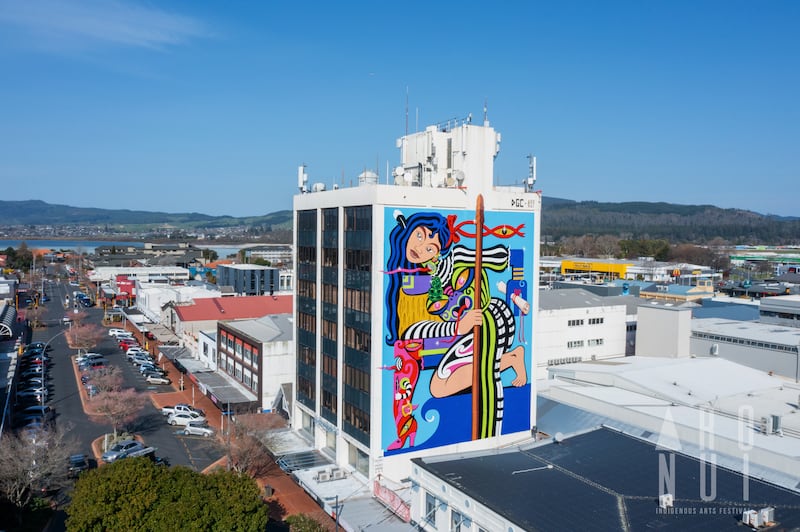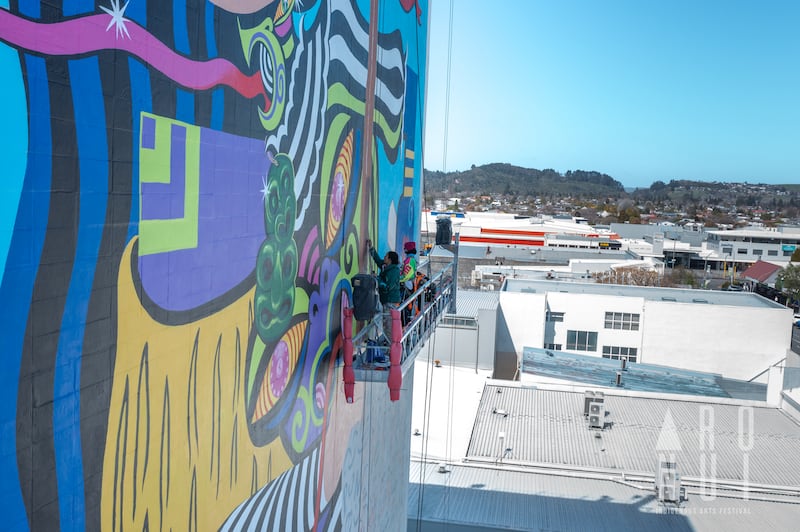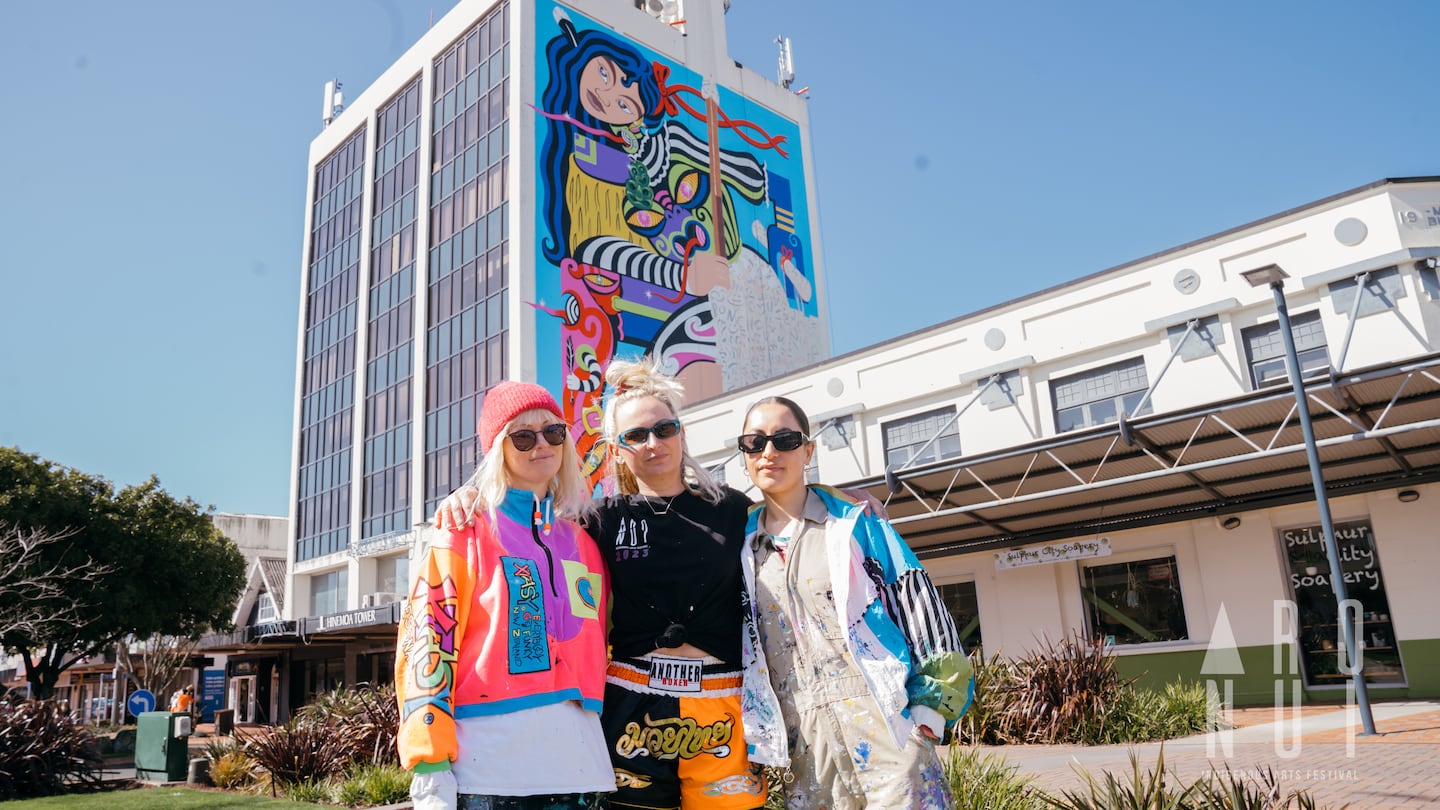A large-scale mural honouring an influential advocate for Māori who was one of Whakarewarewa’s original guides, Mākereti Papakura (Tūhourangi) - known simply as ‘Guide Maggie’ to some - has been unveiled in Rotorua over the weekend.
The artwork by Dreamgirls Arts Collective artists Miriama Grace-Smith (Te Arawa, Ngāti Hau, Ngāti Maniapoto, Ngāti Toa, Ngāti Porou), Xoë Hall (Kai Tahu) and Gina Kiel for the Aronui Indigenous Arts Festival marks the 100-year anniversary since Papakura completed a Bachelor of Science in Anthropology at Oxford University - the first Māori woman in history to do so.

Papakura’s great grand-niece and local artist, June Grant (Tūhourangi, Ngāti Wahiao, Ngāti Tūwharetoa), oversaw the design process for the 24-metre-high homage to the Te Arawa kuia.
“It was a great honour for the descendants of our kuia, Makereti, to see the design unfolding each day, revealing the essence of a life dedicated to sharing cultural imperatives such as tikanga (values), manaakitanga (hospitality) and whanaungatanga (relationships) encapsulated in her thesis entitled ‘The Old Time Māori’. This thesis is in every library, university and archival institution in Aotearoa,” Grant said in a festival release Tuesday evening.
“The mural emphasises significant emblems of Makereti’s journey which are visual references of her life and love of her beloved iwi, Te Arawa.”
Grace-Smith said it was a privilege for the ‘Dreamgirls’ to help bring Papakura’s story to life through the mural and elaborated on various aspects of the artwork in a post on social media.
“What an honour to collaborate with Mākereti’s descendant, June Grant. Ngā mihi @juneairinigrant for your guidance, trust & your creative input to add the design detail for the piupiu,” Grace-Smith wrote.
“Based on Mākereti’s story, her different adornments & clothing represent the two worlds she was part of. Her life & roots here in Aotearoa & her life abroad in England.
“Her hair flows free on one side with her hui feather woven in & a ribbon on the other side, to represent the red headscarf she wore when she was a famous tourist guide at Whakarewarewa thermal valley in Rotorua.
“She wears her Korowai & tiki Te Uoro as well as her 1900′s style dress, the skirt transforms into her piupiu. Her torso is a Taniwha to follow her gut instincts & her neck becomes Taniwha, speaking fluently & fiercely in both languages.
“She wears one boot, a hybrid taniwha/1900′s style boot to represent the merging of two worlds, the other barefoot shows she is grounded in knowing exactly who she is & her whakapapa. She kneels on the wave as she travelled back and forth across the ocean.
“Holding a physical scroll representing her writing achievements in her Taniwha hand, she strongly & unapologetically claims her contribution to literature & representing Māoritanga. She is poised, holding her Taiaha, ready to stand up for who she is, her people, culture & what she believes in no matter how hard the journey.”
The public reaction to the mural has been wonderful, said Grace-Smith.
“Throughout the weeks we received nothing but beautiful reactions while painting and awesome comments from the Rotorua community. Seeing their faces light up and smile as they saw the progress unfold, gave us the boost we needed each day to get to the finish line,” Grace-Smith said in the release.
The Te Arawa artist said it was particularly special for her as someone with whakapapa to the area to spend time there on this kaupapa.
“I am of Te Arawa descent but didn’t grow up knowing much about this side, I have always felt a strong connection to that side and spending time painting in Rotorua these past two weeks has definitely made that connection feel stronger.”

Hall described it as a “healing” time in which the artists looked out for each other throughout an “intense” project.
“A very healing few weeks in Rotorua with my beautiful @official.dreamgirlsart @miriamagracesmithartist @ginakiel_,” Hall wrote on Instagram.
“We looked after and out for each other throughout this extremely intense project as we always do. Intuition and kindness is easy and goes a long way. This is how we work together. That is where the magic is in how we collaborate,” she said.
The 14-day festival concluded in Rotorua on Saturday, with an estimated 500-plus artists included in the programme of indigenous arts activations and more than 8000 people in attendance across the two weeks.




